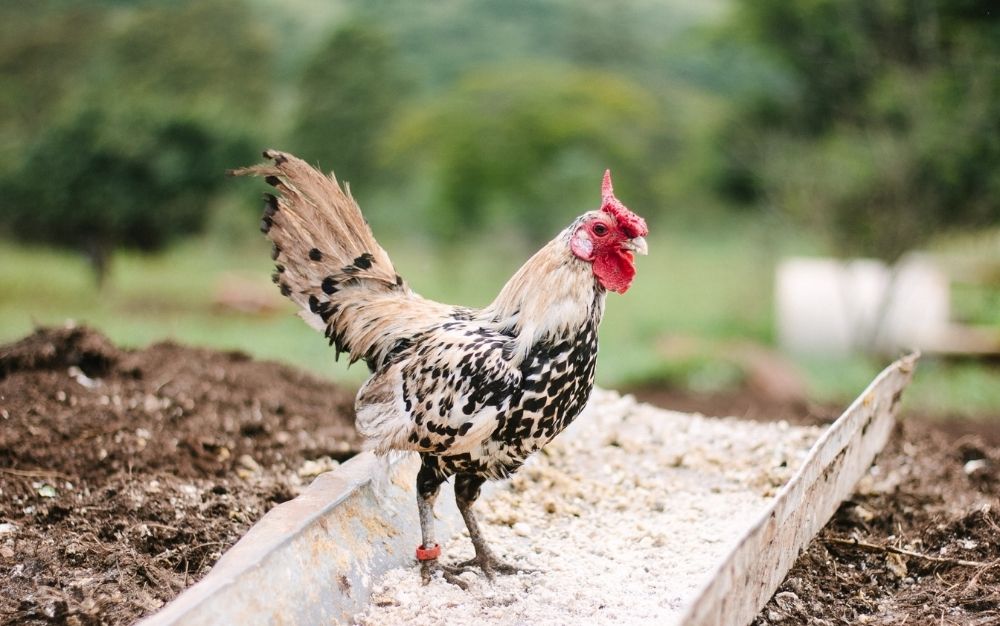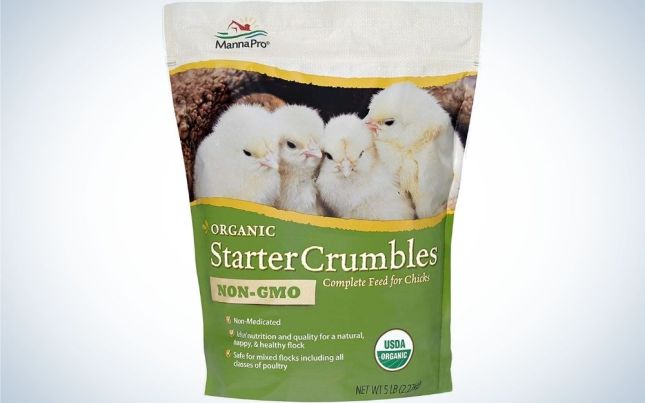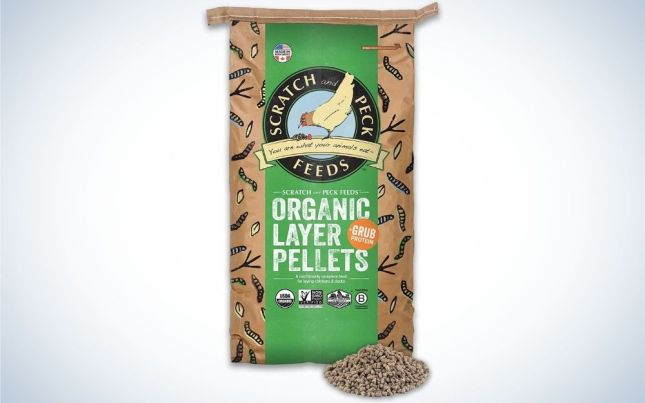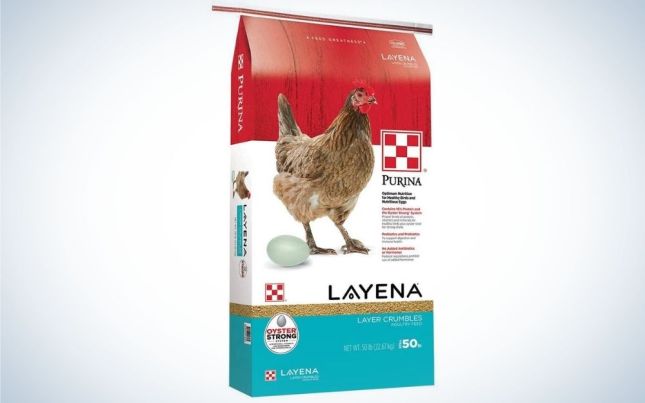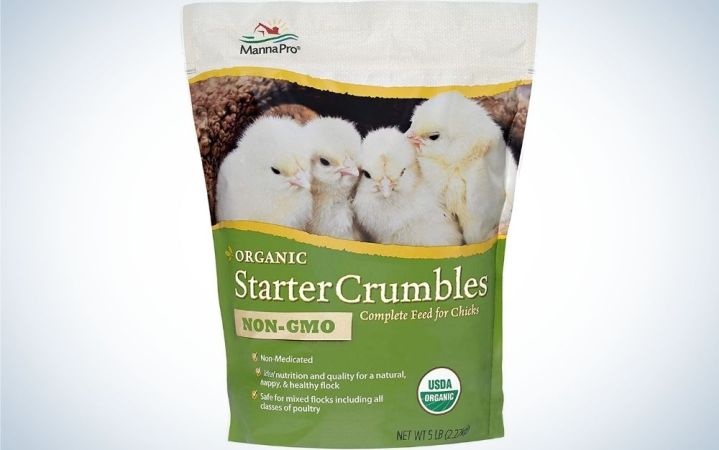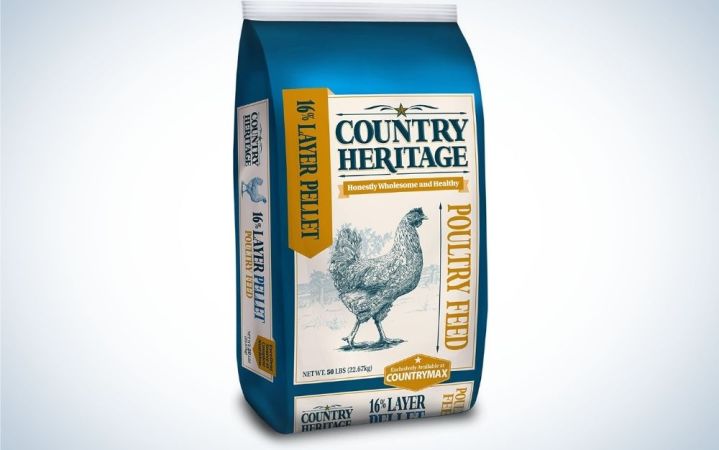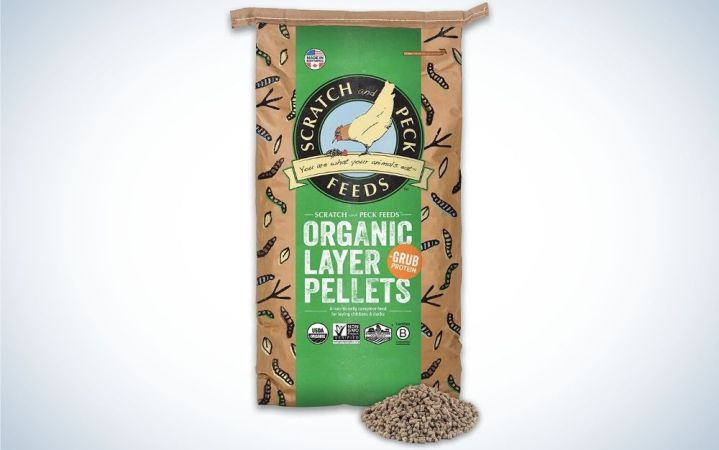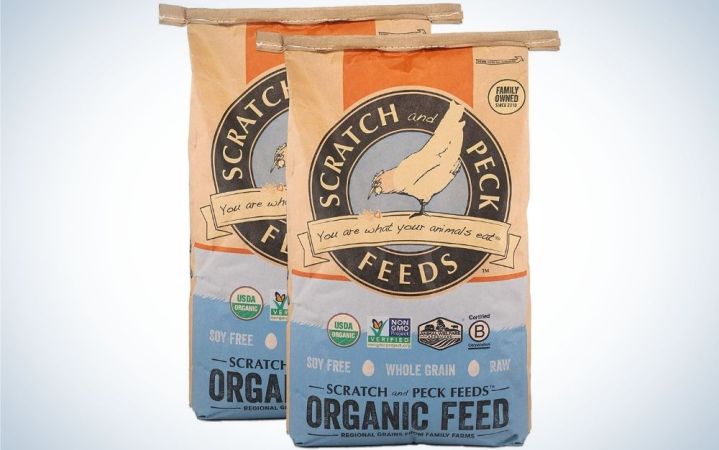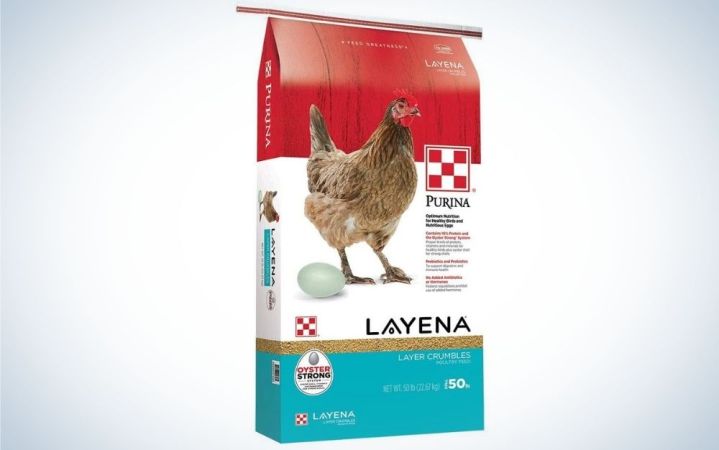We may earn revenue from the products available on this page and participate in affiliate programs. Learn More ›
From soft, contented bedtime clucking to the serious shriek of the egg-laying song, there’s nothing quite like raising chickens. Whether you’re raising those birds for eggs or meat or simply see your chickens as backyard pets, selecting the best chicken feed for your chickens’ unique needs makes a big difference. With so many choices available, figuring out what to feed chickens can be confusing or overwhelming, but it really comes down to a few important considerations.
- Best Starter Chicken Feed: Manna Pro Starter Crumble
- Best Layer Chicken Feed: Country Heritage Egg Layer Pellet
- Best Organic Chicken Feed: Scratch and Peck Organic Layer Pellets
- Best Scratch Chicken Feed: Scratch and Peck Layer Feed
- Best Budget Chicken Feed: Purina Layer Hen Crumbles
A Quick and Dirty Primer on Chicken Keeping
Chickens were the very first bird domesticated by humans, so people have been trying to find the best chicken feed for the job for a very long time. In fact, the archaeological record for chicken keeping dates all the way back to 6000 BCE China—more than 8,000 years ago.
Things have certainly changed since the early days of chicken keeping, but some things remain the same: chicken keepers want to provide their birds the best chicken feed available to keep their flock healthy and maximize their investment.
Fortunately, feeding chickens well comes down to a few basic considerations. First, note your chickens’ life stages and intended purpose. Chick feed has a different nutrition profile when compared with chicken food formulated for adult hens. If you’re raising them for eggs or as meat birds, you’ll need to take that information into account when selecting feed as well.
It’s also important to consider the types of feed you (and your chicks) prefer. This includes the texture and content of the feed as well as any special features, such as a preference for organic chicken feed or non GMO chicken feed.
Finally, consider supplementing your chickens’ diet with extras like oyster shell, greens, and insect treats. This is especially important if your chickens won’t be free ranging and accessing those items on their own.
What to Consider When Selecting Chick Feed
Whether you have freshly hatched chicks running around in the coop or you just brought home a passel of pullets, the single most important consideration when feeding chickens is the birds’ ages and life stages.
Chicks are the youngest poultry and may be purchased at just one day old from a feed store or breeding farm. These birds are covered with fluffy down rather than feathers, so they can’t regulate their own body temperature. Pullets are slightly older and have adult feathers but aren’t regularly laying eggs yet.
For chicks, it’s a good idea to offer chick starter feed. This is the best chicken feed for the youngest birds because it contains 19 to 24 percent protein, which is vital for proper growth. Chick starter is fortified with a good balance of vitamins and minerals but much lower calcium than layer feed. This is important because excess calcium filters through the chicks’ kidneys and may cause health problems.
Most chick starter feed will come in crumble form. These smaller pieces are easier for chicks to manage with their tiny beaks. You’ll need to decide if you prefer chick starter feed medicated with amprolium to protect against the parasite coccidiosis. This is a personal decision, but it’s important to choose unmedicated feed if your chicks are vaccinated or if you are raising chicks and ducklings together.
Best Starter Chicken Feed: Manna Pro Starter Crumble
High Protein
This chick feed contains 19 percent protein and is fortified with vitamins for growing chicks. It’s both USDA certified organic and non-GMO. The unmedicated version is safe for mixed flocks, such as those containing chicks and ducklings together.
What to Consider When Selecting Layer Chicken Food
Adult chickens have their own unique nutritional requirements. This is especially true for laying hens who need a good layer chicken food to stay healthy and produce quality eggs.
Once hens have adult feathers and begin laying eggs, it’s important to switch from starter or grower feed to layer chicken food. This should happen around 20 weeks of age.
Layer feed has less protein than starter at 16 to 18 percent. This is important for the health of adult birds because excess protein is hard on a chicken’s liver. Layer chicken food also contains extra calcium, which is crucial for producing eggs with thick, crunchy shells.
If you find that some of your laying hens still give eggs with thin or soft shells, you may want to supplement with oyster shell to increase the calcium intake in your flock. Alternatively, you can save your hens’ egg shells, grind them coarsely, and offer them to your hens with their feed.
Best Layer Chicken Feed: Country Heritage Egg Layer Pellet
Supports Egg Production
This layer chicken food contains 16 percent protein and is fortified with vitamins and minerals, including 3.8 to 4.8 percent calcium. The pellet form is ideal for minimizing waste when feeding adult birds.
Should You Opt for Organic Chicken Feed?
For chicken food to use a label that indicates it’s organic, it must meet the rigorous standards the USDA sets for organic products. Generally, this means the crop used to produce the organic chicken feed must be grown without pesticides, antibiotics, or synthetic fertilizers. The crop should also be non-GMO, which means the plants are not genetically modified for higher production or greater resistance to pests or chemicals.
The decision to use an organic chicken feed or non GMO chicken feed is a personal one. The quality of the food you provide will eventually affect the quality of the eggs or meat you receive from the chicken. If you follow a strict organic diet yourself or intend to sell your eggs or chickens to customers who do, you should look for chicken feed labeled both organic and non GMO.
Best Organic Chicken Feed: Scratch and Peck Organic Layer Pellets
High Quality Pellet
This organic chicken feed ticks all the boxes for a top tier pellet: organic, non GMO, and free of components that may cause allergy, like soy. It’s 16 percent protein and fortified with grub protein for a natural chicken diet.
What to Look for in Chicken Scratch Feed
Figuring out the best chicken feed gets a little confusing when you throw chicken scratch into the mix. Usually “scratch” refers to low protein, high interest grains that can be offered as treats but really shouldn’t make up the bulk of the chickens’ diet.
However, scratch layer feed is basically the best of both worlds. This is chicken food optimized for laying hens but without the extra processing to pelletize it. As a result, chicken scratch feed looks like what you might picture when you imagine tossing feed to your flock. The only caveat with this feed is that less processed scratch feeds may be more expensive, and some birds can become picky and even resistant to eating pellets, if you want to switch them back.
Some keepers prefer to give their birds fermented feed, and chicken scratch feed is ideal for that. To ferment your feed, place the feed in a bucket and cover with water then let the beneficial bacteria get to work for 2 to 4 days. Fermented chicken food has health benefits for chickens and may result in higher egg production. Plus, chickens require less fermented feed, so it may be a good option to balance your preferences with your budget.
Best Scratch Chicken Feed: Scratch and Peck Layer Feed
Raw and Unprocessed
This chicken scratch feed is a complete layer feed minus the processing, so you can feed your chickens unpelletized whole grains. It’s organic, non GMO, and free of corn and soy allergens.
The Best for Raising Chickens on a Budget
Bottom line: the best chicken feed is the feed that fits into your budget and meets the basic nutritional requirements for chickens and laying hens. Look for a general purpose pellet or crumble with 16 to 18 percent protein and extra calcium, if your hens are laying.
If you want to balance basic budget feed with a high quality diet for happy hens, consider free ranging your chickens, if your space allows. This will give your hens the opportunity to forage for greens and scratch for high protein insects in addition to their regular chicken food.
Best Budget Chicken Feed Product: Purina Layer Hen Crumbles
Complete Nutrition
Purina layer crumble is 16 percent protein with added oyster shell for better egg production. This option also includes probiotics to bolster your chickens’ digestion.
FAQs
When it comes to pellets or crumbles, the best chicken feed depends on your flock. For chicks, pullets, and retired hens, crumbles are easier to pick up and consume. For laying hens, pellets may help reduce waste. Another option is scratch layer feed, which is unprocessed whole grains.
The cheapest way to feed chickens is to select a good quality budget layer feed to meet the basic nutritional requirements for laying hens. To minimize waste, choose a pellet feed. Supplement your flock’s diet with scraps from your kitchen or free ranging to take advantage of greens, insects, and compost that would otherwise go to waste.
How long a 50-pound bag of chicken feed lasts depends on the size of your flock. One laying hen should consume about ¼ pound of feed per day—but chickens really shouldn’t be kept alone. A flock of four eating an average amount would consume an entire 50 pound bag in 50 days.
The Best Chicken Feed is All About Balance
At the end of the day, the best chicken feed for your flock takes into account the chickens’ ages and life stages, the type of feed you prefer to offer (e.g. crumble, pellet, or scratch layer feed), and whether you have dietary preferences, such as organic or non GMO chicken feed. A solid chicken feed and access to foraging will ensure a happy, healthy flock—and that’s no clucking joke. Settle on how to feed chickens and get only the best here.
